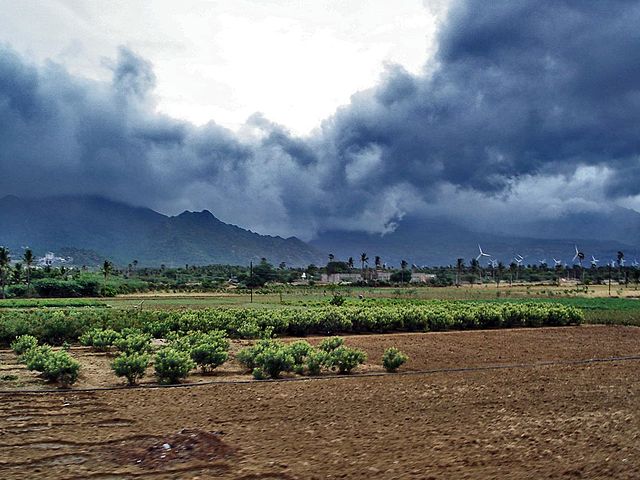Robust monsoon predicted for India
March 31, 2019 | Expert Insights

India’s monsoon, crucial for Asia’s third-largest economy, is likely to be a robust and healthy one this year provided there isn’t a surprise El Nino phenomenon, the top India Meteorological Department official said.
Background
Monsoon is traditionally defined as a seasonal reversing wind accompanied by corresponding changes in precipitation but is now used to describe seasonal changes in atmospheric circulation and precipitation associated with the asymmetric heating of land and sea. Usually, the term monsoon is used to refer to the rainy phase of a seasonally-changing pattern, although technically there is also a dry phase. The term is sometimes incorrectly used for locally heavy but short-term rains, although these rains meet the dictionary definition of monsoon.
The major monsoon systems of the world consist of the West African and Asia-Australian monsoons. The inclusion of the North and South American monsoons with incomplete wind reversal has been debated.
The term was first used in English in British India and neighbouring countries to refer to the big seasonal winds blowing from the Bay of Bengal and the Arabian Sea in the southwest bringing heavy rainfall to the area.
Analysis
Monsoon rains, the lifeblood for India’s farm-dependent $2.6 trillion economy, arrive on the southern tip of Kerala state around June 1 and retreat from the desert state of Rajasthan by September.
India’s 263 million farmers wait for monsoon rains to plant crops such as rice, cane, corn, cotton and soybean because nearly half of the country’s farmland lacks irrigation. Farming output makes up just less than 14 percent of India’s economy but the sector employs more than half of the country’s 1.3 billion population.
The southwestern summer monsoons occur from July through September. The Thar Desert and adjoining areas of the northern and central Indian subcontinent heat up considerably during the hot summers.
This causes a low-pressure area over the northern and central Indian subcontinent. To fill this void, the moisture-laden winds from the Indian Ocean rush into the subcontinent. These winds, rich in moisture, are drawn towards the Himalayas.
The Himalayas act like a high wall, blocking the winds from passing into Central Asia, and forcing them to rise. As the clouds rise, their temperature drops, and precipitation occurs. Some areas of the subcontinent receive up to 10,000 mm (390 in) of rain annually.
“It’s really early to talk about the pattern that this year’s monsoon will follow, but we do know that practically no one is predicting a strong El Nino,” K.J. Ramesh, director general of the state-run India Meteorological Department, told Reuters.
Plentiful monsoon rains could lift agricultural and wider economic growth and keep food prices and overall inflation subdued. That could also add to pressure on India’s central bank to cut interest rates.
On the downside, higher production could mean farmers continue to get hit by low crop prices, a major cause for concern in rural India in the past two years.
A strong El Nino, marked by a warming of the sea surface on the Pacific Ocean, can cause severe drought in Australia, Southeast Asia and India while drenching other parts of the world such as the U.S. Midwest and Brazil in rains.
The emergence of a strong El Nino triggered back-to-back droughts in 2014 and 2015, only for the fourth time in over a century, driving some Indian farmers to penury and suicide. The India Meteorological Department defines average, or normal, rainfall as between 96 percent and 104 percent of a 50-year average of 89 cm for the entire four-month season beginning in June.
In 2017 and 2018, rainfall was 95 percent and 91 percent of the long-term average respectively. The Indian Ocean Dipole (IOD) phenomenon could also be a positive development, said Ramesh.
The IOD phenomenon is characterised by higher sea-surface temperatures in the Indian Ocean. A positive IOD creates a barrier in the eastern Indian Ocean and all the south-westerly winds blow towards the Indian sub-continent, causing rains in the country.
Weather officials say a positive IOD played a big role in bringing adequate rains to India in 1967, 1977, 1997 and 2006.
The India Meteorological Department is likely to make its first official forecast of this year’s monsoon rains by the middle of April.
Assessment
Our assessment is that a ‘normal’ monsoon prediction for India will be expected to bring much-waited relief for drought-prone regions which have had insufficient rainfall for the past three years. We believe that a normal monsoon is beneficial for the largely agrarian-based Indian economy and that it will bring a shower of prosperity for the farmers who have had a troublesome market and climate patterns since 2014.
Image Courtesy: w:user:PlaneMad (https://commons.wikimedia.org/wiki/File:Monsoon_clouds_near_Nagercoil.jpg), „Monsoon clouds near Nagercoil“, https://creativecommons.org/licenses/by-sa/3.0/legalcode








Comments